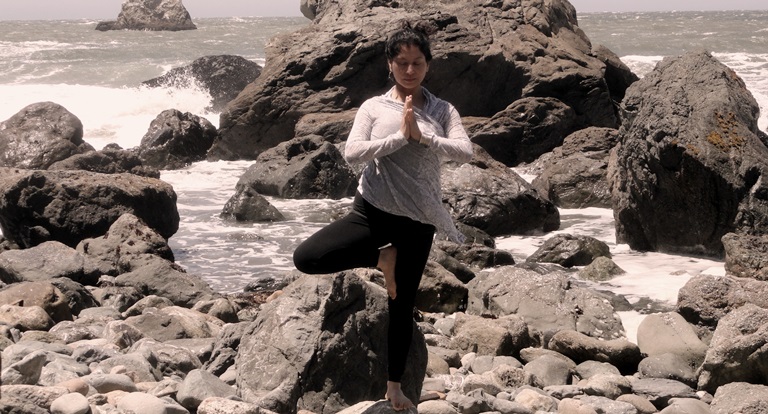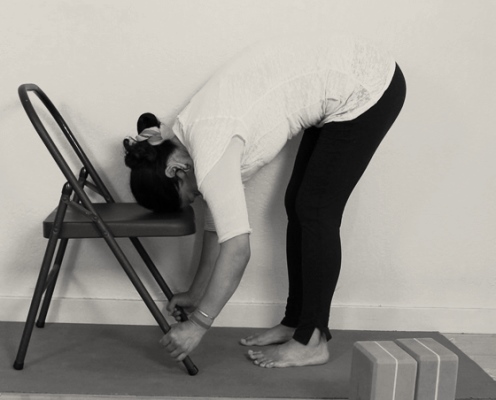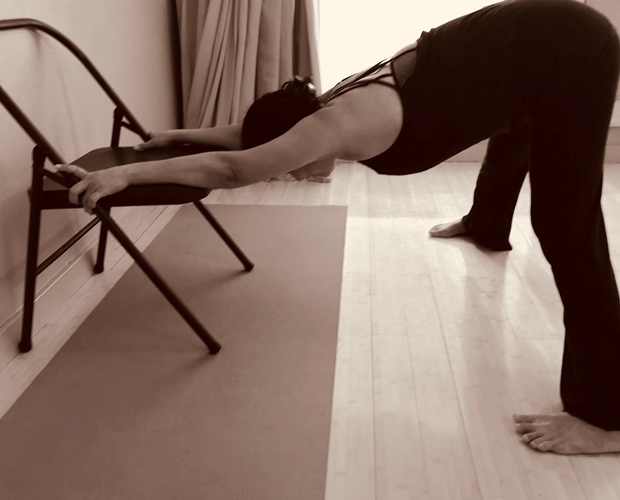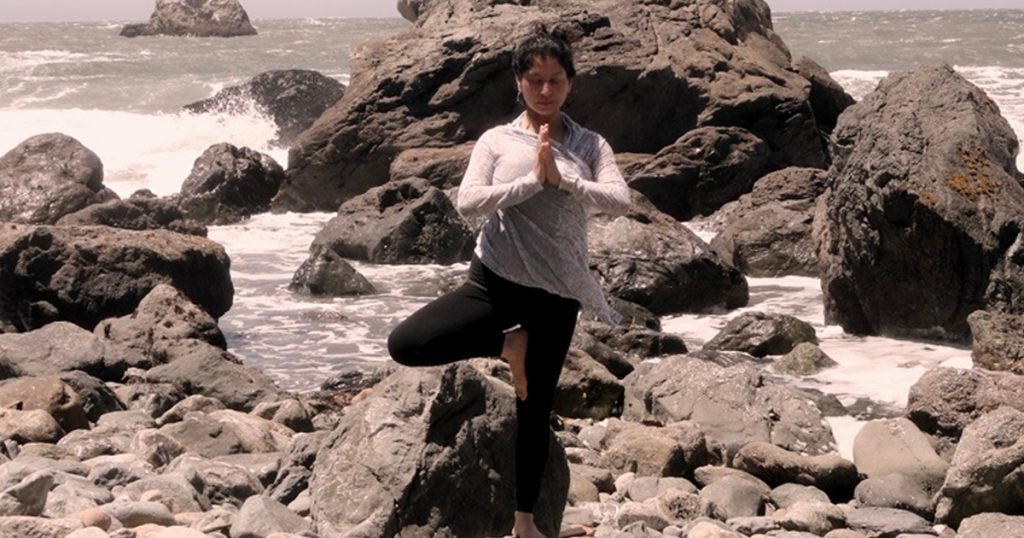The Self brings a feeling of standing on solid ground inside oneself, on a patch of inner eternity which even death cannot touch.
Marie-Louise Von Franz, His Myth in Our Time

OUR SPINE- THE AXIS THAT ALIGNS US BETWEEN HEAVEN AND EARTH
Experts agree that the spine and central nervous system are responsible for controlling virtually every organ, cell, and muscle of our body. The spine is the first structure that forms inside the womb. From the spine, everything else evolves. Hence, the importance of the spine in the practice of yoga. When the spine’s anterior, posterior and lateral muscles are tight, the spine does not move with ease and flexibility and lacks strength. The breath also becomes restricted as the lungs find no room to expand; every other vital organ also begins to live in more constrained spaces. Constricted blood vessels and nerves may lead to pain and rapid aging. It stands to reason that protecting, strengthening and awakening the spine is of utmost importance to the health of our body.
How do we take care of the spine? What is a good, healthy posture?
Aligning bones and muscles of our body is a good way to start. The legs govern the spine 24/7.
In yoga we begin to learn the importance of Mountain Pose (Tadasana). In Mountain Pose we start with the feet. The feet are our foundation for the rest of the body to find its place. We notice how we stand, the position of the knees, inner thighs, hips, spine, chest, and so on. The way the feet are positioned will dictate how the rest of the body is positioned and whether the spine can find freedom and elongation.
As we learn to align our bones and muscles, we can more easily balance and support our body’s weight. When there is unequal distribution of weight we adapt habits and postures that are damaging to the spine. Our body compensates when certain muscles and joints work harder than others to support our musculature. When compensation happens, muscles, tendons, joints and ligaments work harder to support us. This compensation can lead to deterioration and we may feel knee, hip, and/or back pain. As this pattern becomes habitual, we may develop arthritis, headaches, insomnia, and lack of concentration.
When we cultivate a healthy posture, we become aware of our body, the breath, and the things we need to do to age with grace and less pain and suffering. Practicing Yoga Asanas that help us cultivate healthy postures and strengthen our back will help us awaken not only our physical body, but the breath and our life-force. The body can also find more lightness and therefore more contentment.
The Chief Support of our Muscular System is our Back
Everything we do requires us to use our spine. When our spine is injured we can expect limited mobility and much pain. Simple activities such as walking, sitting, gardening, etc. require the strength of the spine. Understanding the role the spine plays in the quality of our lives can make a huge difference in motivating us to take care of it. Breathing, back strengtheners and stretches throughout the day can be of great help to keep our spine flexible and supple.
Major functions of the Spine:
- Protects the spinal cord and associated nerve roots (a damaged or restricted spinal cord can interrupt neural responses, disabling sensation in parts of the body)
- Provides structural support and balance to maintain an upright posture
- Supports the head
- Enables moving and bending (flexion and extension, side bending, left and right rotation)
- Helps the body absorb shock as we walk, run, jump and do other activities
Back problems (Please see Fig A)
Lordosis or swayback: When the lumbar spine is too far inward, it creates an exaggerated curve and affects body posture. It can also affect the lower back and neck, and create pressure, pain, and limited mobility.
Kyphosis: This is a medical term to refer to an excessive outward curvature of the thoracic spine. Kyphosis leads to what is commonly referred to as a “roundback”, or, in a more severe case, a “hunchback”. This condition leads to rounded shoulders, tucked tailbone, weak neck, and overall body weakness and shortness of breath.
Scoliosis: A sideways curve in the spine that has become common in children and adolescents. There are three different types:
- Congenital: some people are born with it
- Idiopathic: unknown cause (most common type)
- Neuromuscular: any condition that affects the nerves and muscles can lead to scoliosis. This is mostly due to muscle imbalance and/or weakness. Common neuromuscular conditions that can lead to scoliosis include cerebral palsy, muscular dystrophy and spinal cord injury

According to renowned Yoga teacher and author Doug Keller, there are 6 million people in the US that have been diagnosed with scoliosis, but there are millions more that have minor scoliotic curvature of the spine and do not know it.
Yoga poses help us cultivate the natural curvatures of the spine as well as strengthen them. Certain poses help us more directly to develop core strength which provides support to our lower back. Back strengtheners keep the back body long and supple and the spine strong and flexible.
Example of back strengtheners and releases: Mountain Pose, Plank Pose (Top of a push-up), Cobra, Bridge Pose, Half or Full Lotus pose, Upward Bow pose, Bow pose, downward Facing Dog and forward folds.
At the physical level, and while there are many other benefits to poses such as Cobra and Locust Pose (Images 1 through 5), these poses will help you strengthen and keep your spine healthy. Child’s pose gently stretches the muscles of the back torso (6). Forward folds keep your spine strong and flexible, and you can even use a chair for support and bend knees as needed (see photos below).



Other tips to take better care of your back:
- Squat if you are lifting something heavy. Exhale, contract the belly and lift.
- Use your breath to move with more ease. Exhalations always help us find lightness and use our muscles in a more effective way.
- Stretch regularly: If you can not have a daily yoga practice, two or three times a week will help you cultivate strength and resilience. Choose other days to walk, swim, or do a home practice.
- Get plenty of rest.
- Visit your chiropractor or get a massage regularly.
- Breathe deeply and drink plenty of water. Hydration helps us maintain the elasticity of the soft tissue and fluidity in the joints.
- Say NO to soft sodas. Sodas are full of refined sugars, which are “empty” calories and offer no nutritional value, plus they will put you at risk for developing diabetes, lethargy, and obesity.
- Eat more vegetables and healthy fats.
- Eat less meat. According to the Arthritis Foundation, meat causes inflammation and is among the biggest sources of saturated fats which cause heart disease and worsen arthritis inflammation.
For more info on inflammatory foods, please visit here: https://www.arthritis.org/living-with-arthritis/arthritis-diet/foods-to-avoid-limit/food-ingredients-and-inflammation.php
Through our yoga practice, we begin to recognize healthy and unhealthy spine curvatures, the tendencies of our physical body, and what we cultivate each day. Like Mr. Keller says, we are not trying to bring our body to a perfect symmetry because we are not symmetrical beings. Through asanas and the breath, we are only understanding our bodies better. In this way, we help balance its actions and reduce the stress we put on our muscles. From this place, we can begin to work on cultivating alignment, strength, proper balance of our body weight, and a more compassionate and holistic approach to self-care.
Our daily asana practice teaches us to embody our physical being in deeper, better ways. Trauma and genes play a big role on our body’s tendencies and how it evolves, but our body is still the best home we will ever have. Taking care of it is our birthright and its care should be seen as a most sacred journey. Remember to also cultivate quiet and restorative time, which is equally important. The best relationship, the most intimate love we can cultivate is with our own selves. Once we understand this our healing path has begun.

